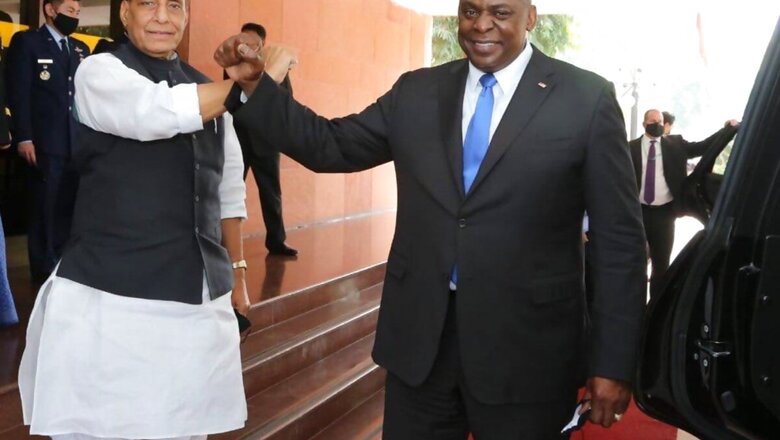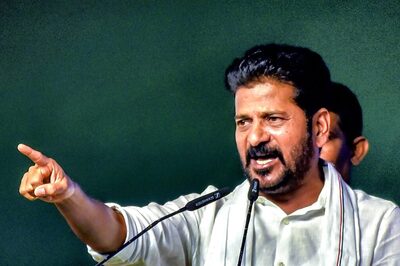
views
The US Secretary of Defence, Lloyd Austin, has completed his three-day visit to India aimed at enhancing military cooperation between the two countries. The visit comes on the heels of a successful QUAD meeting between the leaders of India, Australia, Japan and the US, in which they committed to “promoting a free, open rules-based order, rooted in international law to advance security and prosperity and counter threats to both in the Indo-Pacific and beyond”.
In the past few years, defence cooperation between the US and India has taken a significant upward turn. In 2016, the US designated India as a Major Defence Partner, permitting access to a wide range of military technology. According to the US Department of State Fact Sheet on US Security Cooperation With India, the total defence trade with India has gone from near zero in 2008 to over $20 billion in 2020. Four foundational agreements between the two countries enable the sharing of logistics facilities and exchange of classified information and geospatial data, and have cleared the way for procuring high-end secure communication equipment.
The current trajectory of India-US military cooperation suggests an upward path, but, in reality, it could be tempered by a few factors. The first of these is the rise of China. While both India and the US view growing Chinese assertiveness as the biggest security threat, their approaches to deal with this challenge are different.
President Biden’s Interim National Security Strategic Guidance openly calls out China as the “only competitor potentially capable of combining its economic, diplomatic, military, and technological power to mount a sustained challenge to a stable and open international system”. The first high-level meeting at Alaska between the new US administration officials and their Chinese counterparts was marked by acrimony and sharp exchanges. Bilateral ties that had sunk to a low under President Donald Trump do not appear to be on a path to early recovery. Conversely, we could see an increase in trade and technology barriers between the two countries due to a sharpening geopolitical competition.
In dealing with China, India adopts a more cautious approach, preferring cooperation over competition. Despite the ongoing standoff in Ladakh, India has been measured in its tone and response, displaying firmness while avoiding shrill rhetoric. India’s approach comes from a realisation that an unsettled border with China has the potential for sparking off a conflict, which, at the very least, could have embarrassing political costs.
Therefore, India is careful about not framing its partnerships with other countries as being directed against China. Before Austin visited India, he had attended a 2+2 meeting in Tokyo along with the US Secretary of State, Anthony Blinken. The US-Japan joint statement released after the meeting was highly critical of China for its “unlawful maritime claims and activities” and behaviour that was “inconsistent with the existing international order”, as both the countries committed to “opposing coercion and destabilizing behaviour”. In contrast, there was very little mention of China in the official handouts and press briefings during Austin’s India visit.
In the unfolding great power rivalry, the US would want India to be more steadfast on its side. Ambassador Kenneth I. Juster expressed this in his farewell address in January 2021, where he said:
“Will the evolving international environment require India to adjust how it expresses strategic autonomy? Might practical security needs necessitate building closer operating relationships with a smaller circle of trusted, like-minded partners to best preserve India’s independence of action while protecting it from coercion? And with which nations does India have the best chance of realizing its own ambition of a vibrant, indigenous defense industrial sector? These are important issues for the Government of India to consider.”
India has reiterated on numerous recent occasions that it is committed to the idea of strategic autonomy. For the near future, India is unlikely to get into such a close embrace with the US to rupture its ties with China.
There are two more areas of potential friction. The US administration has been fairly vocal on the sale of the S-400 missile defence system from Russia. India defends the purchase on the grounds that India’s choices for military purchases cannot be dictated by another country. It also does not want to sour its relations with Russia, which has been a reliable and trusted defence supplier for India.
The purchase of S-400 could potentially trigger sanctions under the Countering America’s Adversaries Through Sanctions Act (CAATSA). Even if there is some waiver of the sanctions, some experts point out that induction of the S-400 could limit interoperability with the US equipment that is now being increasingly procured. This could also put some restrictions on future military equipment sales from the US.
Finally, there is President Biden’s stated focus on human rights and concerns that India’s record in this area has weakened. Austin admitted in his media briefing that he had conversations with members of the Indian cabinet on the issue of human rights. India, on the other hand, is extremely sensitive to any criticism of its democratic record. It is often pointed out that matters relating to democratic values and human rights are not likely to impact military cooperation directly. Still, irritants in one area tend to have a spillover effect in other areas.
Looking into the future of India-US defence cooperation, there is an undeniable degree of optimism. Both countries share a strategic vision and need each other to check the aggressive rise of China. However, there are some areas that need to be honestly discussed to come to a shared understanding and to ensure that there are no stumbling blocks in the trajectory of the relationship.
Read all the Latest News, Breaking News and Coronavirus News here


















Comments
0 comment